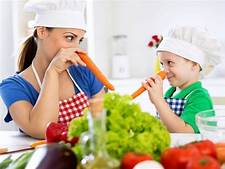We want our children to be smart, healthy and strong, but often the foods that lead to them are not the favorites of the toddlers. How do we shape children’s eating habits and which choices are the best for the growing age?
Diverse and unprocessed foods provide the baby with the necessary vitamins and minerals. The only exception is to give vitamin D in the dark during the autumn and winter, although nutrition counselors have also been exposed to a situation where the levels of vitamin D in children have fallen dangerously by September.
This may be due to wearing long clothes or using sunscreen that prevents the synthesis of vitamins in the subcutaneous layers. However, it is possible to get everything you need with a well-chosen food and in fact, the need for a vitamin D supplement can be lost with a fish and seafood menu.
As age increases, energy consumption increases
The energy needs of children and young people depend on their energy consumption (PAV) and on their growth rate and physical activity. This means that unlike adults, the child also needs energy to grow.
“Children aged 2 to 3 years grow about three percent of their energy and older children less than two percent of their energy,” said Siiri Krümann, board member and nutrition consultant at ETNÜ. “The energy needs of toddlers are lower and the need for energy increases as the age grows.” The child’s energy needs reaches the adult around the age of ten.
When lifting food on a plate, it should be checked that the proportion of macronutrients (carbohydrates, fats, proteins) in children over two years of age would be the same as in adults. This means that between 10% and 20% of the daily energy comes from proteins, 25% to 35% from fats (of which 10% saturated fatty acids) and 50 to 60% from carbohydrates.
In addition, as the child grows, his daily need for vitamins and minerals increases. More than usual, they may need to be in extraordinary cases, such as intense exercise, high stress, illness, etc.
At home, offer food that is rarely found in school-kindergarten
As children spend most of the day in kindergarten or school, it is crucial to take into account the food they offer. In pre-school childcare, food should cover 85-90% of the daily nutritional and food needs of the respective age group.
It is common for a child to have a single meal at home. “The parent could follow the nursery menu and give food at home that is not offered or rarely offered in kindergarten,” Siiri Krümann advised.
“For example, fish, nuts, and seeds are often given in kindergarten, and it is also good to provide children with fruits and vegetables (especially domestic berries) at home. Milk and dairy products are often covered by the daily recommended amount or even larger amount in the nursery menu. So, by eating them, kindergarten children could just be in kindergarten. ”
School children usually eat only lunch at school, so this food should cover 30-35% of the daily food and nutrient requirements of the respective age group. “In the case of schoolchildren, it is more difficult to provide healthy food for growing a child,” Krümann said.
According to her, a schoolboy must definitely eat a nutritious healthy breakfast , and in addition, a school bag of fruit and small handfuls of nuts can be put daily. After school, the child could just wait for the food to be heated, sandwich, yoghurt, etc. It is also important to have a healthy healthy dinner with your family.
“The problem with schoolchildren is also that school meals are offered already from 10 am to 11 am, so children do not eat at home in the morning and there is a very long time for dinner,” the nutritionist explained. “At the same time, when breakfast is not eaten, there is a strong correlation between the prevalence of children and the ability to learn and concentrate.”
When a child eats too much or little
According to nutrition adviser Siiri Krümann, children often have periods when they eat more appetite and those who consume less food. Here is an important indicator of weight and growth chart, which shows whether a child is in normal weight.
“A child with a very good taste, who has problems with weight, could offer less energy-intensive foods: plenty of vegetables, lesser fruit and berries, legumes, whole grains,” Krümann said. “Restricting sugar-rich and refined foods is worth limiting.” If the child eats too little, the nutritionist says it is first worth watching what he eats and drinking between meals. Also, one cookie or glass of sweet drink (including natural juice) can break the appetite.
It is of utmost importance to monitor the nutrition of teenagers, because on the one hand, their nutritional need increases, but on the other hand, poor diets, unhealthy eating habits, energy and protein deficits and many vitamins and minerals can occur. Vitamins need a person for normal growth, development, reproduction, metabolism, healthy survival, disease prevention and healing.
Nutrients and minerals ensure that the child has normal metabolism, nerves and muscles work as needed, and the bones develop normally. “Young people of this age are experimenting with different diets. There may also be eating disorders that make it important to notice changes in the young’s eating behavior as early as possible, ”said Krümann.
According to him, eating a snack is typical of teen nutrition. At the same time, it is important to keep up with the fast food and snacks, as they often contain a lot of salt / sugar, processed fats and additives, and little fiber and other necessary nutrients. Two to three intermediate pieces per day are recommended, but no continuous twisting. It would be good to eat fruit, nuts, whole-grain bread or unflavoured yogurt as a snack, rather than a sweet drink, crunch, cookie, pie or candy.
“Teenagers are hard to influence. They did not listen to the teachings – eat what they want and when they want, “was characterized by a nutritionist. “They should be directed to a healthy diet so that they do not notice it. It is very important to have healthy food at home here. Keep fruit and vegetables, nuts and seeds in the middle. ”
Children’s Nutrition – How can a child feed useful food?
Parents are often faced with the fact that shrubs do not dare or want to try new foods. To avoid this, it is useful to offer foods with different textures and flavors from a tiny point of view. “Certainly, you should not just stay with the couple’s favorite food, because there is a high probability that the child will not accept new flavors later,” the nutrition counselor advised.
According to food recommendations, children should eat 3 to 7 servings of vegetables a day, depending on age, physical activity and gender. It’s about 300 to 600 grams. “When eating such a variety of fruits, it is likely that the body will receive the necessary amount of many vitamins and minerals as well as the necessary phytotoxic, water and fiber. The more different and colorful the vegetables are, the better, ”Krümann said.
There are children who are happy to crispy raw vegetables and also like eating soups or stews. For many, however, a little bit of cunning or food needs to be served more interestingly. The new Nutrition School program of the Estonian Nutrition Advisers Association can also be helpful, which teaches the child about the world of food with the help of all senses.
According to Krümann, it would be best for the parent to reach an agreement with the sucker and to explain why one or the other fruit is beneficial to her, instead of hiding the vegetables in the food. However, if this does not work, luckily there are plenty of options – vegetables can be added to both breakfast and dinner, both sweet and salty, so the child won’t notice it.
Useful tips for a parent
“It is quite common to have a cucumber, tomato, pepper and salad leaf on a sandwich. Vegetable grease from legumes that are greased to bread or dip for vegetables could also contain a variety of vegetables, such as baked beets, carrots, or peppers, ”Krümann advised.
“In addition to onion, mushrooms and paprika, grated zucchini is also delicious in omelette. With its mild taste, it fits in many foods: it can be grated in oatmeal, cutlet or sweet cake. In addition, the zucchini can be made with spaghetti with a regular vegetable cutter or spoon and half of the real carrots on the child’s plate can be replaced with them. The pumpkin puree is also suitable for the morning bud, which makes the rice porridge very yellow, for example, and the pumpkin fits into the oatmeal. ”
On the advice of a nutritionist, adding potatoes is richer with the addition of cauliflower, pumpkin, lingonberry or lentils, but it is important that the vegetables are cooked soft enough to make the potato nicely foamy. Cauliflower is also good for rice – kids don’t notice it. The cauliflower must simply be pre-grated with a fine grater and lightly creased. The result is quite rice-like and tastes good when mixed with ordinary rice.
How to Make Foods Sharp
Children’s big favorites – meatballs and macaroni – can also be tuned to healthier. If the zucchini crackers do not sit, the wholemeal paste is always a healthier choice. There are also very interesting macaroni in the shops, for example, made of buttermilk or legumes. However, on the recommendation of a nutritional adviser, about half of the meat consumed by meatballs may be replaced by grated carrots, zucchini, beet, cabbage or some legume, eg chickpeas, lentils or beans.
The child can be sure to ask what color of macaroni he wants today and, according to the order, puree the vegetables in the pasta sauce: carrots, cakes, cauliflower or broccoli. “The kids love the colors and give the name of the colorful macaroni a hero of the child, so the food tastes good – be it a cartoon character Shrek or a brave dinosaur,” Krümann gave interesting advice.
Many colors can also be added to the soups by placing noodles, cauliflower, broccoli, turkey beans, peas, beers, laughs, etc. Vegetables should also be cooked in the oven at the same time as chicken or fish. “Otherwise, stewed vegetables would not be happy on the child’s plate, but they are better suited as colored frets – carrots, beets, parsnips, and french fries can cut pieces of french fries that splash some olive oil and herb salt and taste very well,” Krümann taught. “Broccoli and cauliflowers can also be sprinkled with a little olive oil and seasoned with herb salt, but they also taste very well with grated cheese.”
Similarly, you can also play sweet pastries. Muffins, cakes, oatmeal biscuits, chocolate biscuits – vegetables can be added everywhere. “By experimenting with such vegetables and adding them to bold foods, a baby with a little appetite can get a variety of vegetable and vegetable vegetables every day to provide enough vitamins, minerals, fiber and phytotropic ingredients to grow,” Krümann encouraged parents to test.
Children’s foods should be kept away from excessively processed cuts
Kids love colors and joyful food. In their food choices, they rely on adults, so they have to set a good example and keep their children’s nutrition full.
Kids love colors and joyful food. In their food choices, they rely on adults, so they have to set a good example and keep their children’s nutrition full.
Although children tend to love crispy, soft drinks and pastries, because of their low nutritional value and high fat, salt or sugar content, they do not have the right place in the menu for the child to grow up.
Crispy and french fries can be cooked successfully from different vegetables at home, and the shops also have a very good mix of vegetables. “Here is a very important example for parents – how and what is eaten at home and what is found in the cabinet.” Likewise, eating in fast food places should not be made a reward or a part of the anniversary. It is worth choosing a café or a restaurant with healthier choices in the menu, ”stressed the nutritionist.
According to him, attention should be paid to the fact that the child follows the example of the parents and the number of overweight children is increasing. “There is also an increased prevalence of obesity-related diseases, type II diabetes, high blood pressure, orthopedic diseases and benign obesity in the liver, as well as hormonal disorders.”
Parents should note that the smaller the child, the more their choices depend on home life. “It is extremely sad to see if a toddler eats vines and French fries or the like,” said Krümann. “She can’t read the menu by herself, how does such food reach her plate?”
Even on birthdays, the board does not have to have the usual French fries with wine or potato chips. Children can very well appreciate food art, cheerfully served vegetables and fruits are very good commodities, and fresh berries (frozen well in winter). Likewise, homemade French fries or vegetable meatballs are suitable. Drinking water with berries, cucumbers or fruit fits well.
Prefer local goods
Since the baby’s diet should largely contain fruit and vegetables, the question arises as to whether the fruits that have come from distant countries to Estonia in the winter are still healthy and rich in vitamins. Siiri Krümann advises, if possible, to prefer domestic and soft products, but the main thing is that different vegetables and fruits will reach the plate at all.
“Immediately after harvesting, enzymatic decomposition processes in fruit and vegetables, especially vitamin loss, begin. Loss of nutrients occurs through light, air and heat. Vitamin C, the B vitamins and carotenoids, is fastest decreasing, ”Krümann explained.
“In vegetables, vitamins are slightly better. It is advisable to eat, for example, potassium in the spring to obtain vitamin C, because it lacks the ascorbinase that decomposes vitamin C and the vitamin C content is not reduced under the right storage conditions. ”It also has a good source of vitamin C in winter and early spring in unheated sauerkraut.
One good solution is also to consume frozen fruits, because the vitamin loss is relatively small (freezing fast and very low temperature).
No more than two candies a day
The fact is that children love sweet and often adolescents grab a large chocolate bar during a tighter period of study. However, and how much the growing organism really needs sweet?
“Carbohydrates are the body’s main source of energy – all carbohydrates , including fiber, should provide 50-60% of the daily recommended dietary energy for adults and children over the age of two,” Siiri Krümann explained.
Our body, especially the brain, needs continuous glucose supply to function effectively. “In addition to the naturally occurring glucose in food (such as fruit, berries, man, juice, etc.), it also occurs in the digestive tract of starch and sucrose in food. Examples of starch and sucrose include potatoes, bread, macaroni, porridge, fruit and vegetables, ”he said.
We love to say that the brain needs sugar, but in fact, glucose from good and healthy food needs the brain, or the child does not need to eat sweets in addition to a full meal. This is especially the case where many foods already contain sugar, such as bread, yogurt, ketchup, etc.
“The added sugars should not give more than 10%, ideally they should provide less than 5% of the daily recommended energy,” Krümann put the parents at heart. “This means that a child should eat 2-3 small biscuits a day or 2-3 sweets.” In the case of sweet dessert, she suggests offering (dried) fruits, berries, nuts, seeds or making cakes and muffins with, for example, vegetables and vegetables.
If a child complains of constant sweetness, it may be a deficiency of vitamin B and / or minerals. More bread, nuts and seeds can be useful here. It may also be a problem with irregular eating, too long meal breaks or refined carbohydrates.





















